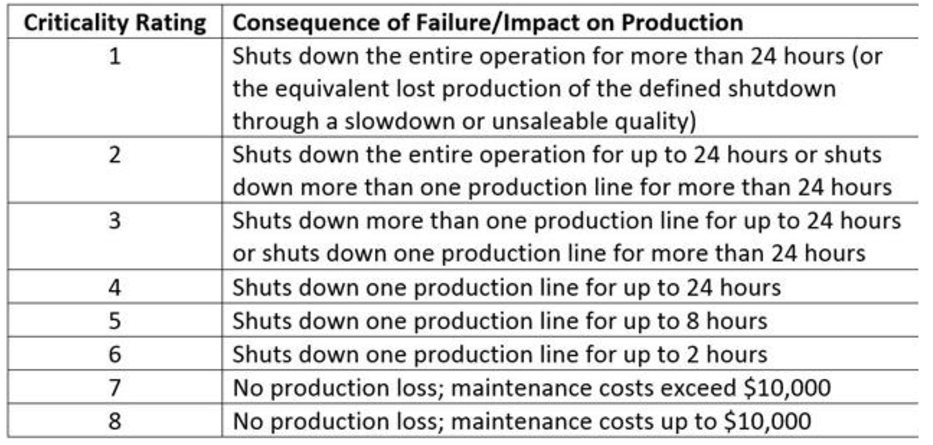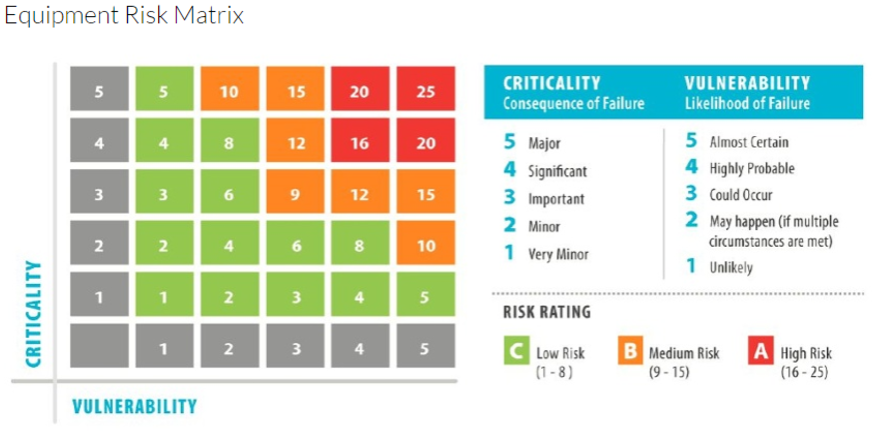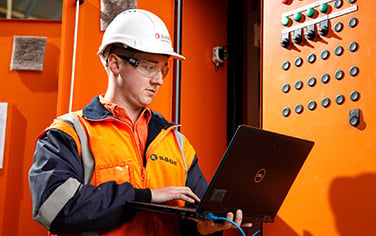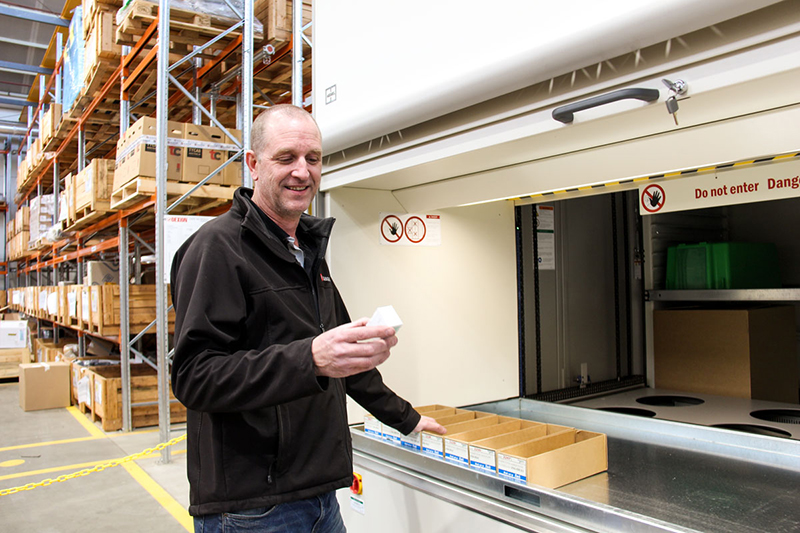Equipment criticality ratings and why they are so crucial to manufacturing maintenance
SAGE Automation, Published: August 29, 2017 - Updated: October 13, 2023 (8 min read)
It’s widely agreed that equipment criticality ratings (ECR), also sometimes known as machine criticality ratings (MCR), are an important part of designing and setting manufacturing maintenance priorities.
We asked our National Service Manager why ECR is so critical to your plant, and how it can help reduce and prevent downtime.
Q. What is equipment criticality rating (ECR)?
A. It’s really just a form of risk assessment, which evaluates the consequence and likelihood of failure of a specific item within a larger system, such as a manufacturing line. Highly critical machines are those that production depends on most. If these go down, production stops or bottlenecks occur.

An example of a ‘consequence of failure’ scale (Source: ReliablePlant)
- Q. Why do you need to know the equipment’s criticality rating?
A. Knowing how critical every piece of equipment is for production will help determine what targeted preventative actions are needed to reduce downtime when it occurs, as well as prevent it altogether. An ECR that shows business-wide consequences associated with equipment failure will prove ROI for prevention and response programs.
In short, you’ll be better prepared for inevitable machine failure, get back online faster and prioritise prevention and response measures.
Q. How do I work out the ECR?
A. There’s no one method for finding the ECR. It can be very complex, because each facility, and each individual component within that facility, differs. For example, a motor or wiper blade can stop production, but time out of service will differ for each component, resulting in a different rating.
Some suggest that equipment criticality rating should be done on this component level, while others say this overcomplicates things.
I would personally suggest approaching finding the ECR like this:
1. Design: Identify risks in your overall setup
Use production and plant design to help you identify which lines are at most risk. Then focus ECR here. For example, if you have multiple manufacturing lines that produce different products but have the ability to interchange, this reduces the risk. BUT if one of those lines is the only packaging line in the plant, and a piece of equipment goes down there, it stops everything. This line is where the most risk lies, as there’s potential to bottleneck all production.
2. Consequences of failure: Rate each component’s importance to production on each line
Give every critical component (equipment or machine) a rank based on what would happen if it failed. This could simply be a ranking from 1–5, where 5 is a major consequence (e.g. plant-wide downtime for 24 hours or more) and 1 is very minor consequence (e.g. no downtime, but repair costs). Make your own ranking scale based on your context.
3. Probability of failure: Rate machine/equipment on likelihood of failure
Give every critical component a rank based on its likelihood of failure within a predetermined time. Again, this could be a ranking from 1–5, where 5 is extremely likely and 1 is unlikely. A motor that runs 24 hours a day in extreme heat and dust will likely rank in category 5. As with the consequences of failure ranking scale, you should make your own ranking scale based on your context.
Some predictive maintenance techniques may help quantify rankings, but experienced maintenance technicians and operators will be able to make these judgements.
4. Calculate the ECR
Plot the ‘consequences of failure’ and ‘probability of failure’ on a matrix to find the most at-risk components.
Here’s an example of an equipment risk matrix (Note: every plant’s ranking scale will be different):

Source: Prometheus Group.
Q. What should I do once I find the ECR?
A. Once you know which machines and associated equipment and parts are most critical, you need to feed that information back into plant design, prevention, and response procedures. Make sure you:
- have the right spares on-site
- prioritise staff training/knowledge on the machines for fast repair recovery
- make sure preventative maintenance is adequate
- get documentation and drawings up-to-date
- put in place redundancies in the event of failure.
Q. What do manufacturers do well?
A. Most manufacturers have sound manufacturing maintenance regimes and they already understand their equipment criticality on an intuitive level. Many also have redundancies built into their processes for when machines fail, meaning they can afford to wait for a service provider to fix the faulty machine.
Q. What can manufacturers improve on?
A. Remember to follow up your ECR (or any risk assessment) with solid prevention and redundancy programs.
Manufacturers should also be aware that criticality ratings can change, depending on, for example, part availability, or suppliers no longer manufacturing the product. Be sure to schedule in time to revise criticality ratings, so you know you’re spending resources in the right areas.
Q. Who’s responsible for ECR?
A. Leaders and managers within the business have to own ECR, because they’re the only ones who fully understand the impact that equipment failure has on their production and profitability.
Sometimes channel managers and automation service providers who are in tune with risk will start driving the conversation down the path of determining the ECR; however, the ultimate responsibility still lies with the business.
ECR is key to any sound manufacturing maintenance regime
ECR is one of many proactive and preventative measures that helps production managers prioritise their resources and drive improvements. To learn more about how we’ve worked with businesses to drive improvements, see our work with Coopers.
When a machine stops, it can quickly escalate to calling in external help – sometimes unnecessarily. The Breakdown Checklist is designed to get you back online faster. It will get your team thinking about what caused the breakdown and assess the need for external advice. Download the free downtime checklist here.
SAGE Automation delivers agile, scalable and secure solutions that don’t just solve current problems, they preempt and deter future ones, helping your organisation thrive. With years of experience working in defence, infrastructure, resources, utilities and manufacturing we have the expertise you need to custom-build or perform manufacturing maintenance on your equipment for maximum ROI.









